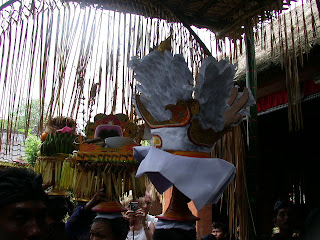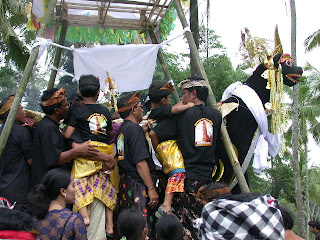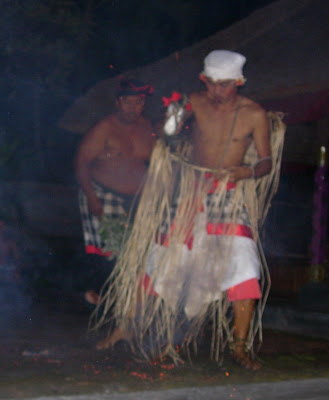Our perception of God is sure to have undergone some transformation since the time we were toddlers. A toddler's understanding of God cannot be the same as that of an adult. But on a broader plane, humanity's perception of God also differs from culture to culture and from time to time even within the same religious culture. As always, I will only zoom in on my own religion which I'm familiar with.
Almighty God, in the Christian sense, has not meant the same thing throughout the ages. He started out as a more physical or carnal version of the divine. He made many physical appearances . He was weaker and less knowledgeable. He had a face that could be seen but nobody dared to view his face and they were content to look only at his back. He didn't know why Adam and Eve hid themselves away and had to ask them. Of course apologists scramble to explain that He knew all along but just asked anyway, possibly to get them to confess. He also wrestled with Jacob all night. A subsequent generation re-wrote the passage and referred to God in this wrestling match as "the angel of the Lord". But as always, when scribes re-write the Bible, they are averse to changing everything probably out of reverence for the text they consider sacred and so the passage looks odd with the angel of the Lord also being referred to as God himself. Elsewhere, we read of the angel of the Lord receiving worship, which in the Judeo-Christian tradition is reserved purely for God. The Church tries to explain away this anomaly by postulating that the angel of the Lord is the pre-incarnate Christ.
That leads to a problem more thorny than the original one that we have. We are precisely a month away from Trinity Sunday (which falls on 15 June this year), a day that meant a lot to me many years ago when I was an altar boy. Trinity Sunday is an important day in church. It's one of the Principal Feasts and I liked the day mainly because we would recite the Athanasian Creed which I found quite hilarious. That's a creed which we don't always say because it's so long and convoluted and if anyone is going to trip over his creed, it's got to be this creed. I thought of it as an amusing creed and the name ascribed to it in our prayer book, "Quicunque vult" made it, at least to me, the clown of all creeds. But the creed underlines the basis of our faith, or so my vicar (who subsequently became an Archdeacon) told me. It separates the world into believers who say the creed and heretics who don't. The Creed and Trinity Sunday were devised to dispel the Arian Heresy.
Briefly, all Christians, whether they are Roman Catholics, Protestants or Orthodox, believe in God as the Holy Trinity. The Arian Heresy is the heresy that declares God the Father to be above the other two, namely, Jesus and the Holy Spirit. But the dispute only came about in the 4th century. There were notable scholars and theologians in the 3rd century who had a belief that although predates the Arian belief is similar to it but I'll talk about them later.
Every Christian is taught from the cradle that there is one God, one Lord but three Persons.
In the Athanasian Creed, we say that the Father is God, the Son is God and the Holy Spirit is God and yet there are not three Gods but one God. Why is that so? That's because the unity of God is central to the Old Testament and the whole of the Old Testament also forms a part of the Holy Bible which we Christians revere as the Word of God.
In the Athanasian Creed, we recite that the Father is Lord, the Son is Lord and the Holy Spirit is Lord and yet there are not three Lords but one Lord. Now, why do we say that? Again, because in the Old Testament, God commands the people to recite the shema twice a day: "Hear O Israel! The Lord thy God is one Lord". So we can't have three Lords but only one Lord.
Any Jew today will tell you that to call Jesus Lord and the Father Lord and the Holy Spirit Lord would be to contravene the clear wording of the shema. What the Church has done is to play around with words. We insist that all three are Lord but there is only one Lord and yet the three are distinct.
What the Church does is to introduce a new term into the idea of God. And that term is "Person". As the Creed provides, there are three Persons in the Holy Trinity. We don't say three Gods because that would fly against the very pillar of monotheism which Christianity claims to be and we don't say three Lords because that would contravene the precise wording of the shema. But we say three Persons because the word "Person" is a new introduction into the religion.
But just think about it for a moment. How would the writers of the Old Testament prevent our Christian introduction of the Holy Trinity into the concept of God? What they have devised is as clear as it can be. "Hear O Israel! The Lord thy God is one Lord". How were they to know that we would introduce "Person" into the Godhead? Even if they had said "The Lord thy God is one Lord and one Person", I assure you the Church would have said the Father is a Person, Jesus is a Person and the Holy Spirit is a Person and yet there are not three Persons but one Person. And then we will introduce another term, perhaps "Entity" and say God is in three Entities. It's one God, one Lord, one Person but three Entities. That's how creative the Church is.
Origen
This has not always been so for the Christian Church. In the third century, the great Christian scholar and theologian, Origen, who was a prolific writer of theological books declared that Jesus was the firstborn of all creation, ie Jesus was the first creation of God. But he didn't get into trouble because the Church had not yet come up with its clear teaching of the Holy Trinity. In other words, the properties and nature of God had not yet been fully determined by the Church. Besides, he was merely repeating the words of St Paul which appear in our Holy Bible that Jesus is "the firstborn of all creation". Of course at that time, the Church had not reinterpreted that verse to declare that the firstborn of all creation is not a creation. This may sound strange to non-Christians who are not used to the concept of reinterpretation by the Church. Whenever we encounter a problem verse in the Bible that doesn't square with the doctrines the church has come up with, what the church does is to reinterpret the verse to mean something the language itself does not mean. We do the same thing with verses that are obviously wrong. Eg when Jesus declared in at least five different places in the Holy Gospels that he would return to earth in the lifetime of his first apostles and obviously he didn't, the church decides that Jesus didn't mean that when he said that.
So, no Christian will have a problem with saying that although Jesus, according to the Holy Bible, is proclaimed to be the firstborn of all creation, he was never a part of creation. We follow the reinterpretation of the church and to hell with the clear wording of the Bible.
But how was poor Origen to know that in less than a hundred years after his death, the Church would redefine the properties of God so that Jesus became co-eternal with the Father? All Origen's books were declared anathema by the church and poor Origen became a heretic posthumously. What a rotten thing to do to a person who cut off his own genitals just so that he didn't sin against God with his lust. Again, this is what Jesus says in the St Matthew that if your hand causes you to sin, cut it off and throw it into the fire. Poor Origen made the horrible mistake of following the Bible too closely.
In St John's Gospel, Jesus says, "If you loved me, you would be glad that I am going to the Father, for the Father is greater than I". Arian heretics have all depended on this verse to justify their belief that Jesus is not equal to the Father. But if you don't go along with the Church's redefinition of God, you're a heretic, never mind the biblical verses you can call upon to justify your stand.
So the way I see it as we progress towards the holy Principal Feast of Trinity Sunday, God has undergone various redefinitions over the centuries. He started out as the God of a nomadic tribe and he was more earthy and physical; he appeared in person and although nobody dared to look at his face, they all saw his back. So God had a back like any creature that can be gazed upon. He even wrestled with Jacob for the whole duration of the night. Of course Christian theologians have given a thousand different meanings to that episode and have romanticised it and infused the wrestling God with the Person of the Pre-incarnate Christ but that's a later reinterpretation. As the Israelites settled down, God took on a more spiritual nature and became less earthy but at the same time, he became more powerful and omniscient. And his unity or one-ness is emphasised. God is One. Jesus started out as someone subject to God. But by the time the Gospel of St John was written (that's the last of the canonical Gospel to be written), Jesus had assumed divine stature but God the Father was still greater than he (John 14:28). By the late 4th century and certainly by the First Council of Constantinople, the co-equality of Jesus with the Father became indisputable and if you don't say "Credo" to that, you're a heretic and all your books anathematised.
What do I see for the future of God in this age of easy access to information and beyond this age? Will God further evolve into anything else? God has transformed from being physical to spiritual. Will God undergo a further transformation so that he becomes metaphorical? I see that as a very likely possibility but the church moves slowly and woe betide anyone who goes ahead of the church. He'll be branded a heretic.




















































 .
.
 .
.
 .
.
 .
.
 .
.

 .
.
 .
.
 .
.